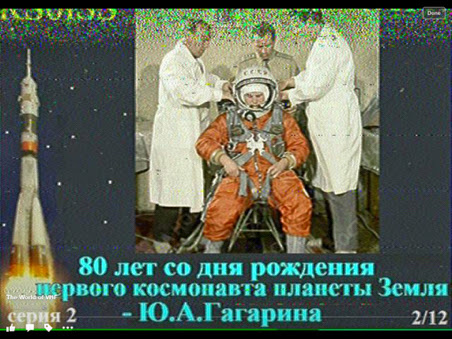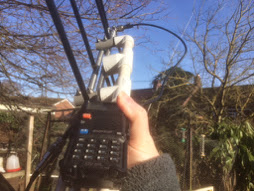Author Archive
 A little DSTAR activity
A little DSTAR activity
I generally use for the gateway has been busy on ADS-B duty. Last weekend, I remembered
I could easily fire up Win-DV on the PC and use the DVAP with that.
A couple of nice QSOs this morning with that setup; John LA2QAA and Des G0RBD. Time to reinstate the Sunday morning DSTAR sessions as I do the chores around the house and garden.
 A little DSTAR activity
A little DSTAR activity
I generally use for the gateway has been busy on ADS-B duty. Last weekend, I remembered
I could easily fire up Win-DV on the PC and use the DVAP with that.
A couple of nice QSOs this morning with that setup; John LA2QAA and Des G0RBD. Time to reinstate the Sunday morning DSTAR sessions as I do the chores around the house and garden.
 Receiving SSTV from the International Space Station
Receiving SSTV from the International Space Station
You might remember that before Christmas, I missed the opportunity to try receiving some SSTV pictures from the ISS. Although I missed it, I took the chance to get the SSTV program working with the FT-8900.
At the end of last week, I learned that there would be some more SSTV activity from the space station, so was keen to try it out.
It worked really well. Some images were better than others and others were better than I expected them to be. A real surprise was a surprisingly good decode from a pass when the ISS was a modest 1 degree over the horizon.
The best images were from high elevation passes though. As ever the gear was simple, V2000 vertical, FT-8900 and MMSSTV on the PC.


 Receiving SSTV from the International Space Station
Receiving SSTV from the International Space Station
You might remember that before Christmas, I missed the opportunity to try receiving some SSTV pictures from the ISS. Although I missed it, I took the chance to get the SSTV program working with the FT-8900.
At the end of last week, I learned that there would be some more SSTV activity from the space station, so was keen to try it out.
It worked really well. Some images were better than others and others were better than I expected them to be. A real surprise was a surprisingly good decode from a pass when the ISS was a modest 1 degree over the horizon.
The best images were from high elevation passes though. As ever the gear was simple, V2000 vertical, FT-8900 and MMSSTV on the PC.


 First garden portable activity of the year on SO-50
First garden portable activity of the year on SO-50

Yesterday, it was a cold but dry day and I thought it would be fun to go out in the garden and see what I could hear and work on SO-50. I quickly put a bit of charge into the UV-5R portable and assembled the Elk yagi.
The first pass I tried was off to the east and although I could hear plenty, I didn’t manage a QSO. The next pass after that was pretty much overhead and I was a lot more successful, working 2E1EBX also using handheld gear, over on the Norfolk coast and then Yuri, UT1FG/MM in IO90 on his way up to Hull.
Really enjoyable and not too cold.
 First garden portable activity of the year on SO-50
First garden portable activity of the year on SO-50

Yesterday, it was a cold but dry day and I thought it would be fun to go out in the garden and see what I could hear and work on SO-50. I quickly put a bit of charge into the UV-5R portable and assembled the Elk yagi.
The first pass I tried was off to the east and although I could hear plenty, I didn’t manage a QSO. The next pass after that was pretty much overhead and I was a lot more successful, working 2E1EBX also using handheld gear, over on the Norfolk coast and then Yuri, UT1FG/MM in IO90 on his way up to Hull.
Really enjoyable and not too cold.
 Bouncing a signal through the NO-44 satellite
Bouncing a signal through the NO-44 satellite
One of my favourite tweeters on radio matters is Patrick WD9EWK Patrick is a keen member of AMSAT and the wider amateur satellite community. Just recently, Patrick has been experimenting sending APRS packets through the old NO-44 satellite.
NO-44 or PCSAT is one of those satellites that is in its’, er, twilight years. The battery failed some time ago and now the satellite operates when the solar panels can supply it enough power to make it go. It was and is, an APRS digipeater in space. Recently, Patrick has shown making keyboard to keyboard APRS QSOs through NO-44 as well as simply digipeating his own signals. Patrick had used his Kenwood APRS enabled handheld and his handheld Arrow antenna.
I thought I should try! I noticed a pass this morning where NO-44 was in sun all the way up over the South Atlantic before passing directly overhead us here in the UK, so got the ‘usual’ ISS packet setup going, using the V-2000 vertical and wondered if I would hear anything.
All was quiet until I calculated the satellite was almost directly overhead and I send a packet, with the unproto path set to PCSAT via W3ADO-1 To my surprise, I heard a weak packet. Too weak for me to decode, but as I discovered later, thanks to Paul N8HM, the ON7EQ-1 gateway heard it and retransmitted it and plotted me on the map you’ll see below












